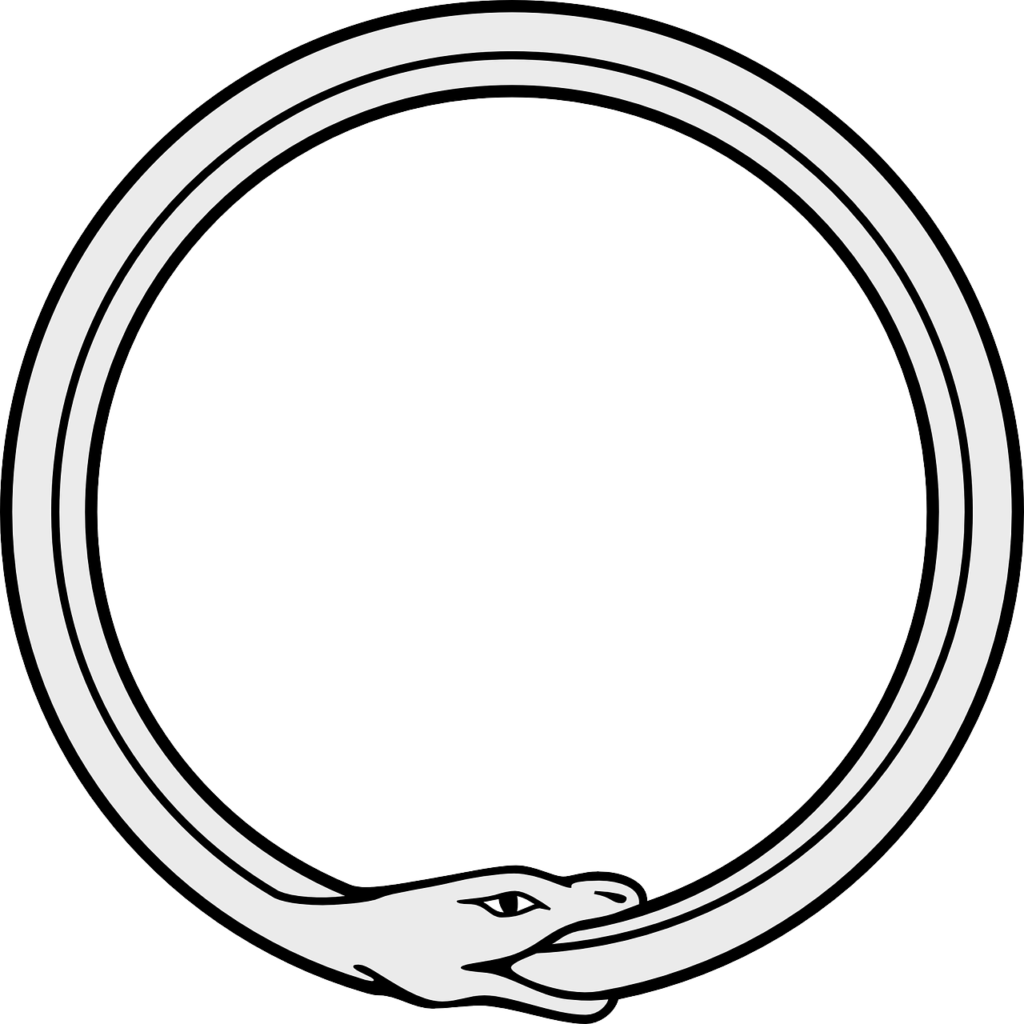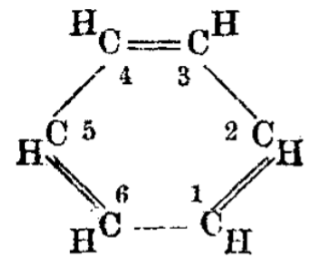Tamara Allen
“I turned my chair toward the fireplace and sank into half-sleep. Again the atoms fluttered before my eyes. . . . Long lines, often combined more densely; everything in motion, twisting and turning like snakes. But look, what was that? One of the snakes had seized its own tail, and the figure whirled mockingly before my eyes. . . .”[1]
So goes the story of August Kekulé’s inspiration for his skeletal depiction of benzene as a six-carbon cyclic compound with alternating single and double bonds (depicted using lines):[2]
With the 1865 proposal of his dream-inspired ring hypothesis (and his later publications of a refined structure that more closely resembles the modern benzene structural depiction),[3] Kekulé shed light on a mystery that had stumped chemists since the discovery of benzene in 1825.[4] For forty years, chemists had struggled to divine a structure that would explain both the superior stability and unique reactivity of benzene.[5] Kekulé’s intellectual contribution regarding “the simplest and most fundamental structure of the aromatic compounds” has provided the foundation for advances in the theory of aromaticity,[6] opening the door to developments in the synthesis of “dye-stuffs, medicines, and other organic chemicals.”[7]
Shifting to a legal perspective: the creation of any innovative and useful idea prompts one to wonder how the originator can protect (and thus, profit off of) her intellectual property rights in her idea. Applying modern legal principles to the inventive landscape of the 1860s, how might Kekulé have protected his intellectual property rights in his structural depiction of benzene?
Broadly speaking, “intellectual property is any product of the human mind which the law protects against unauthorized use by others;” this includes patents, trademarks, copyrights, and trade secrets.[8] This article will address whether Kekulé could have used Copyright Law to protect his benzene depiction.[9]
The United States Constitution grants Congress the power “To promote the Progress of . . . useful Arts, by securing for limited Times to Authors . . . the exclusive right to their . . . Writings . . . .”[10] The statutory source of federal copyright protection is the Copyright Act of 1976 (“Copyright Act”).[11] For Kekulé’s benzene depiction to fall within the scope of copyrightable subject matter, it must be an (1) original (2) work of authorship that is (3) fixed in a tangible medium.[12]
For a work to be “original,” it must be independently created by its author, and it must possess “at least some minimal degree of creativity.” [13] In other words, a work is not copyrightable if the author copied another’s work to make it. However, even if an author’s work is identical to another’s prior work, it may still be copyrightable so long as the author independently created it.[14] Thus, “originality” hinges on the author’s independent source of inspiration for her work rather than the uniqueness or novelty of the work itself.
Under this definition, Kekulé’s benzene depiction would likely be found to be “original.” Kekulé derived the idea from his dream of snakes and tails—in other words he independently created it.[15] Even if another “author” independently reached the same structure before Kekulé, another’s independent creation does not bar Kekulé’s copyright prospects so long as the other author cannot prove that Kekulé copied that author.[16] Additionally, given that chemists struggled to determine the structure of benzene for forty years before Kekulé found a solution,[17] his depiction likely meets the “at least minimally creative” threshold for the originality requirement. Thus, Kekulé’s benzene structure is likely “original.”
Next, Kekulé’s structural depiction of benzene must have been a “work of authorship.” A work of authorship can be pictorial or graphic[18] “two-dimensional . . . diagrams [and] models.”[19] This subject matter category is limited by the “Useful Articles Doctrine,” which limits the scope of copyrightable subject material to only the pictorial or graphic elements “that can be identified separately from, and are capable of existing independently of, the utilitarian aspects of the article.”[20] A “useful article” is one that has “an intrinsic utilitarian function that is not merely to portray the appearance of the article or to convey information.”[21]
In Kekulé’s case, benzene is depicted as a drawing of a hexagon with alternating single and double bonds.[22] The primary purpose of the depiction is likely to “portray the appearance of . . . or convey information” about the molecule that makes up benzene in its physical form. Therefore, the danger that the Useful Articles Doctrine seeks to prevent—“the open-ended extension of copyright protection to all manner of useful articles”—is not implicated here.[23] In other words, a copyright covering a drawn depiction of benzene could not be extended to benzene in its physical form, so an application of the Useful Articles Doctrine would serve no purpose. Therefore, Kekulé’s benzene depiction is likely a pictorial “work of authorship” within the scope of Section 102(a)(5).
The final Section 102(a) requirement for copyrightable subject matter is that the work of authorship be “fixed in any tangible medium of expression . . . from which they can be perceived, reproduced, or otherwise communicated.”[24] In Kekulé’s case, the moment he drew his structure of benzene in a workbook, he “fixed” his “original work of authorship” in a “tangible medium of expression.”
Thus, Kekulé’s benzene depiction likely falls within the Section 102(a) scope of copyrightable subject matter; however, Section 102(b) presents a significant obstacle in Kekulé’s path to copyright protection. Section 102(b) establishes: “In no case does copyright protection for an original work of authorship extend to any idea, procedure, process, system, method of operation, concept, principle, or discovery, regardless of the form in which it is described, explained, illustrated, or embodied in such work.”[25] As stated by the Supreme Court, “[t]he most fundamental axiom of copyright law is that ‘no other may copyright his ideas or the facts he narrates.’”[26]
Regarding ideas, a distinction is made between the expression of an idea, and the idea that is being expressed.[27] Therefore, to overcome the per se uncopyrightable idea of benzene as a cyclic six-carbon compound with alternating single and double bonds (representing the idea of a delocalized electron system, as we understand it now),[28] Kekulé’s copyright should be directed only at the pictorial expression of benzene which uses single and double lines arranged to convey information about the characteristics of benzene.
Another argument against finding that Kekulé’s benzene depiction is copyrightable is that Kekulé has merely discovered a “scientific fact as to the nature of the physical world,” such that he “may not claim to be the ‘author’ of that fact.”[29] This argument relies on the premise that Kekulé’s benzene depiction is factual in nature, i.e., that Kekulé has merely discovered the structure of benzene as it “actually exists.”[30] In the 1860s, Kekulé likely could have countered that his depiction of benzene was not a fact, but a hypothesis. However, in today’s world, the depicted structure of benzene may be so generally accepted in the scientific community as to be considered a legal fact (even if scientifically, the proposed structure remains hypothetical).
In conclusion, so long as Kekulé’s benzene depiction is not barred by Section 102(b), it likely falls within the scope of copyrightable subject matter. Exactly how Kekulé may have enforced such a copyright is another question entirely!
[1] Alan J. Rocke, It Began with a Daydream: The 150th Anniversary of the Kekulé Benzene Structure, Angewandte Chemie Int’l Ed. 46, 46 (2015) (quoting Richard Anschütz, August Kekulé 941–42 (1929)).
[2] Illustration of Kekulé’s Benzene Structure, in August Kekulé, Ueber einige Condensationsproducte des Aldehyds*), 162 Justus Liebigs Annalen der Chemie 77, 88 (1872).
[3] See id.
[4] Jonathon Clayden et. al., Organic Chemistry 143 (2d ed. 2012). Some controversy exists over whether Kekulé is the true originator of the benzene ring structure; however, such priority disputes fall outside of the scope of this article. Id. at 24.
[5] Id. at 143, 156–57.
[6] Aromaticity is “difficult to define,” but to put it simply: aromatic compounds share certain structural and electronic characteristics which cause them to be “exceptionally stable.” Id. at 160–61.
[7] Shigeaki Kikuchi, A History of the Structural Theory of Benzene – The Aromatic Sextet Rule and Hückel’s Rule, 74 J. Chem. Educ. 194, 194 (1997).
[8] 37 Am. Jur. 3d Proof of Facts §§ 1–2 (1996), Westlaw (database updated Dec. 2023).
[9] This narrow question is specifically directed at whether Kekulé’s arrangement of lines to convey information about a theoretical structure of benzene would have been copyrightable subject matter under the current copyrightable subject matter statute, 17 U.S.C. § 102. This discussion does not consider (1) Kekulé’s general method of using skeletal structure to depict chemical compounds; (2) Kekulé’s potential scope of copyright enforcement power; or (3) IP protections in benzene as a physical chemical.
[10] U.S. Const. art. I, § 8, cl. 8.
[11] 17 U.S.C. §§ 101–1511.
[12] § 102(a).
[13] Feist Publ’ns, Inc. v. Rural Tel. Serv. Co., 499 U.S. 340, 345 (1991).
[14] Id.
[15] Rocke, supra note 1, at 46.
[16] 1 Melville B. Nimmer & David Nimmer, Nimmer on Copyright § 2.01, LexisNexis (database updated Dec. 2023) [hereinafter “Nimmer”] (quoting Sheldon v. Metro-Goldwyn Pictures Corp., 81 F.2d 49, 54 (2d Cir. 1936)) (“[T]he copyright owner must establish both substantial similarity and copying, ‘for just as he is no less an “author” because others have preceded him, so another who follows him is not a tortfeasor unless he pirates his work.’”).
[17] Clayden et. al., supra note 4, at 143.
[18] 17 U.S.C. § 102(a)(5).
[19] § 101.
[20] Id.
[21] Id.
[22] Clayden et. al., supra note 4, at 143.
[23] See Nimmer, supra note 16, at § 2A.08.
[24] 17 U.S.C. § 102(a).
[25] § 102(b).
[26] Feist Publ’ns, Inc. v. Rural Tel. Serv. Co., 499 U.S. 340, 345–46 (1991) (quoting Harper & Row, Publishers, Inc. v. Nation Enters., 471 U.S. 539, 556 (1985)).
[27] Nimmer, supra note 16, at § 2.03(D)(1).
[28] Clayden et. al., supra note 4, at 143.
[29] Nimmer, supra note 16, at § 2.03(E) (citing Feist Publ’ns, Inc., 499 U.S. 349 at 348).
[30] Fact, Black’s Law Dictionary (11th ed. 2019).


